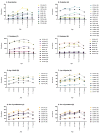Age-Related Changes in Post-Translational Modifications of Proteins from Whole Male and Female Skeletal Elements
- PMID: 37446562
- PMCID: PMC10343923
- DOI: 10.3390/molecules28134899
Age-Related Changes in Post-Translational Modifications of Proteins from Whole Male and Female Skeletal Elements
Abstract
One of the key questions in forensic cases relates to some form of age inference, whether this is how old a crime scene is, when in time a particular crime was committed, or how old the victim was at the time of the crime. These age-related estimations are currently achieved through morphological methods with varying degrees of accuracy. As a result, biomolecular approaches are considered of great interest, with the relative abundances of several protein markers already recognized for their potential forensic significance; however, one of the greatest advantages of proteomic investigations over genomics ones is the wide range of post-translational modifications (PTMs) that make for a complex but highly dynamic resource of information. Here, we explore the abundance of several PTMs including the glycosylation, deamidation, and oxidation of several key proteins (collagen, fetuin A, biglycan, serum albumin, fibronectin and osteopontin) as being of potential value to the development of an age estimation tool worthy of further evaluation in forensic contexts. We find that glycosylations lowered into adulthood but deamidation and oxidation increased in the same age range.
Keywords: biological age estimation; forensic proteomics; post-translational modifications; rat bone.
Conflict of interest statement
The authors declare no conflict of interest.
Figures





Similar articles
-
Relative Protein Abundances and Biological Ageing in Whole Skeletal Elements.J Proteome Res. 2021 Jan 1;20(1):538-548. doi: 10.1021/acs.jproteome.0c00555. Epub 2020 Oct 22. J Proteome Res. 2021. PMID: 33089684
-
Forensic proteomics for the evaluation of the post-mortem decay in bones.J Proteomics. 2018 Apr 15;177:21-30. doi: 10.1016/j.jprot.2018.01.016. Epub 2018 Jan 31. J Proteomics. 2018. PMID: 29407476
-
Trends in deamidation across archaeological bones, ceramics and dental calculus.Methods. 2022 Apr;200:67-79. doi: 10.1016/j.ymeth.2021.08.004. Epub 2021 Aug 25. Methods. 2022. PMID: 34450289
-
Proteomics of post-translational modifications in colorectal cancer: Discovery of new biomarkers.Biochim Biophys Acta Rev Cancer. 2022 Jul;1877(4):188735. doi: 10.1016/j.bbcan.2022.188735. Epub 2022 May 13. Biochim Biophys Acta Rev Cancer. 2022. PMID: 35577141 Review.
-
Current proteomic analysis and post-translational modifications of biomarkers in human lung cancer materials.Chang Gung Med J. 2008 Sep-Oct;31(5):417-30. Chang Gung Med J. 2008. PMID: 19097588 Review.
Cited by
-
Bioinspired Synthesis of Allysine for Late-Stage Functionalization of Peptides.Angew Chem Int Ed Engl. 2024 May 27;63(22):e202403215. doi: 10.1002/anie.202403215. Epub 2024 Mar 26. Angew Chem Int Ed Engl. 2024. PMID: 38529755 Free PMC article.
-
Osteoporosis: Molecular Pathology, Diagnostics, and Therapeutics.Int J Mol Sci. 2023 Sep 26;24(19):14583. doi: 10.3390/ijms241914583. Int J Mol Sci. 2023. PMID: 37834025 Free PMC article. Review.
References
-
- Parker G.J., Leppert T., Anex D.S., Hilmer J.K., Matsunami N., Baird L., Stevens J., Parsawar K., Durbin-Johnson B.P., Rocke D.M., et al. Demonstration of Protein-Based Human Identification Using the Hair Shaft Proteome. PLoS ONE. 2016;11:e0160653. doi: 10.1371/journal.pone.0160653. - DOI - PMC - PubMed
-
- Wadsworth C., Procopio N., Anderung C., Carretero J.-M., Iriarte E., Valdiosera C., Elburg R., Penkman K., Buckley M. Comparing ancient DNA survival and proteome content in 69 archaeological cattle tooth and bone samples from multiple European sites. J. Proteom. 2017;158:1–8. doi: 10.1016/j.jprot.2017.01.004. - DOI - PubMed
-
- Buckley M., Wadsworth C. Proteome degradation in ancient bone: Diagenesis and phylogenetic potential. Palaeogeogr. Palaeoclimatol. Palaeoecol. 2014;416:69–79. doi: 10.1016/j.palaeo.2014.06.026. - DOI
MeSH terms
Substances
Grants and funding
LinkOut - more resources
Full Text Sources
Molecular Biology Databases
Research Materials
Miscellaneous

